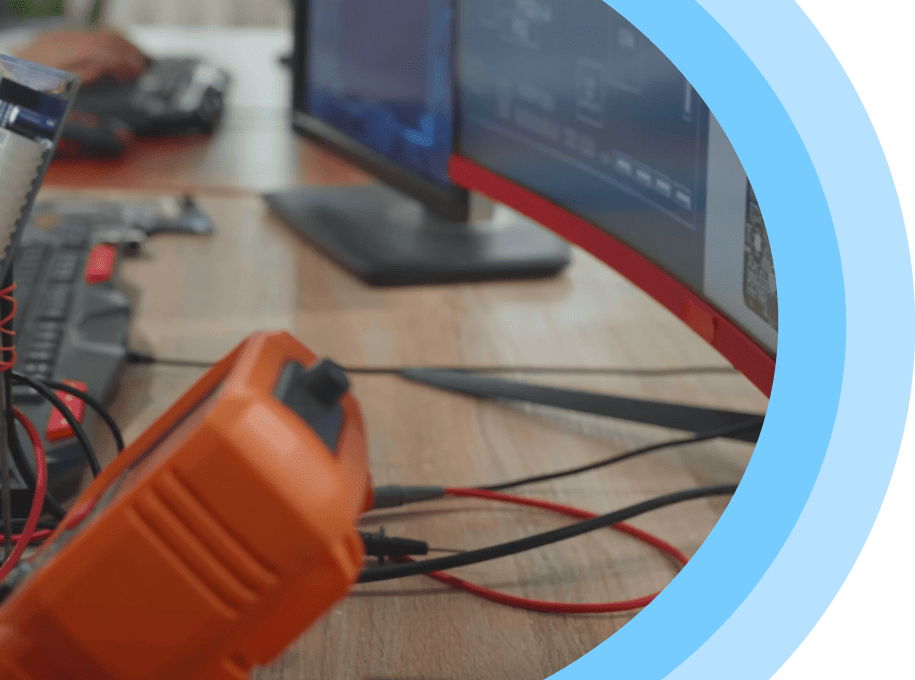New Batch Starts In a Week
AMBA Protocol training is focused on all the aspects of APB, AXI and AHB from scratch covering all the aspects from signals, timing diagram, all the features.
Next Batch
1-1 Dedicated Mentor Support
24/7 Tool Access
Multiple Mock Interviews
Industry Standard Projects
Support with Resume Update
AMBA Protocol Training Overview
Course Overview
AMBA Protocol training is structured to enable engineers gain perfection in AXI, AHB & APB protocols. Majority of designs are based on ARM architecture. All ARM architectures are based on AMBA protocols(AXI, AHB and APB), which makes it essential for every design & verification engineer to have detailed understanding of these protocols. SoC design debug and testbench component coding in most cases involves either AXI and/or AHB protocols, and also majority of interviews are focused on candidate familiarity with AXI or AHB protocol. All this makes it essential for every VLSI engineer to have good working knowledge of these protocols.
AMBA Protocol training course focuses on teaching protocol concepts, features, timing diagrams from basic to advanced for AXI4.0, AHB2.0 and APB. Course also focus on teaching protocol testbench development concepts. Student has flexibility to choose specific protocol as well.
On-chip protocols
Peripheral protocols
Importance of AMBA protocols for VLSI engineer?
APB protocol basics
Features
APB system architecture
Signal descriptions
APB transaction state diagram
AXI Protocol features
AMBA protocol overview
ARM processor - categories
AMBA Protocol basics
Comparison of APB, AHB and AXI protocols.
Correlating AXI with APB protocol
Features added in AXI on top of APB protocol
Introduction
SOC Architecture – Significance of AXI protocol
AXI architecture components
How five channels help AXI protocol?
Write & Read Channels
AXI Channel handshaking
Write Channel Signals – Address, Data and Response
Read Channel Signals – Address and Data
Ports added in AXI protocol
Write Transaction Timing Diagram
How to draw timing diagrams?
Read Transaction Timing Diagram
Big endian and little-endian architecture
Wrap write and read transactions
Narrow transfers
Data bus and strobe relation
Responses in AXI
Locked and exclusive transfers
Aligned and unaligned transfers
Overlapping, out of order, interleaved txs
Interconnect role in out of order transaction
Significance of ID in AXI protocol
AXI Channel handshake dependency
Cacheable and bufferable transactions
Protected transactions
New ports added
Memory attributes signalling
Modifiable transactions
Non-modifiable transactions
Read-allocate and write-allocate
Memory types
Transaction buffering
QoS signalling
Multiple region signalling
User-defined signalling
Need for UVC?
Different types of UVC's
Active
Master
Slave
Passive
UVC usage in module and SOC verification
Where Passive UVC are used?
UVC integration into TB
AXI UVC architecture
AXI Transaction Definition
AXI UVC component coding
Driver, sequencer, monitor, coverage
Environment, interface, slave model
Transaction, assertions
AXI UVC integration
AXI scoreboard coding
UVC integration in SOC TB
Testcase and sequence coding
Waveform analysis
Assertion coding and analysis
Functional coverage analysis
AHB and AXI: How they differ?
AHB based system architecture
AHB transfers: Various phases
Arbitration Phase
Address Phase
Data Phase
Burst transfers
Aligned transfers
Narrow transfers
Incrementing and wrapping transactions
Exclusive transfers
Exclusive access monitor
Exclusive Access signaling
Exclusive transfer restrictions
Resp signal
Two cycle response
Split and retry responses
UVC architecture
UVC components
UVC types
Master, slave
Active, Passive
UVC test case listing down
UVC component coding
Driver, sequencer, monitor, coverage
Environment, interface, slave model
Transaction, assertions
UVC Component integration
Sequence and test case development
Simulations, waveform analysis
Functional coverage analysis
Assertion coding and analysis

Key Features
Who All Can Attend This AMBA Protocol Training?
This training is ideal for professionals and graduates aiming to work on ARM-based SoC designs, with a focus on understanding and implementing AMBA protocols in VLSI design and verification flows. It is highly relevant for those involved in IP development, integration, and verification.Pre-requisites To Take AMBA (AXI, AHB, And APB) Protocol Training
- Exposure to any bus protocols like I2C, SPI, etc.
- Exposure to digital design concepts
High Demand for AMBA (AXI, AHB, And APB) Protocol Training
Know about the Growing VLSI industry
Verification engineers with strong protocol-level knowledge (especially AXI/AMBA) are highly valued in SoC and IP verification teams. Engineers skilled in UVM, SV, and protocol debugging typically work on high-speed interconnects and gain quicker access to lead or architect roles.
₹7 LPA
₹11 LPA
₹15 LPA
₹19 LPA
₹25 LPA


- Customized training programs for teams
- Upskill and reskill employees with industry-relevant content
- Interactive sessions led by expert trainers
- Hands-on projects and real-world case studies
- Flexible delivery in online
- Improve productivity and efficiency
- Access to training resources and material

- Learn in real-time with instructor-led sessions
- Flexible access from anywhere
- Recorded sessions available for revision
- Training on industry-standard tools
- Get certification after completion

- Self-paced learning as per your flexibility
- Industry-aligned learning modules
- Certification after course completion
- Access to structured video lessons and materials
- Track your progress step by step
- Access to learning materials for more than 1.5 years
AMBA Protocol Training is essential because AXI, AHB, and APB are the backbone of most ARM-based SoCs, prevalent in the VLSI industry. Mastering these protocols is crucial for effective design, verification, and debugging of complex integrated circuits. A strong understanding significantly enhances employability in VLSI roles, as most interviews heavily focus on AMBA protocol knowledge. This training equips engineers with the necessary skills for success in the core of modern VLSI design.
Career Path
Learning Path

At VLSIGuru, we believe that education should lead to meaningful employment. Our training programs are designed not just to impart technical excellence, but also to bridge the gap between academic learning and industry demands. With a strong network of hiring partners and a proven track record, we ensure that our students are career-ready.
Placement Highlights
- Industry-aligned curriculum
- Hands-on projects and case studies
- Communication skills
- Resume building and interview preparation
- Technical and HR mock sessions
- Aptitude and domain-specific test series
- Regular drives and exclusive hiring events with partner companies
- Resume building and interview preparation

At VLSIGURU, we provide industry-focused VLSI training and guidance that helps students and professionals build strong technical skills and succeed in their careers. Our programs are designed to be practical, flexible, and aligned with current industry requirements.
Student Reviews




Frequently Asked Questions
- Course presentations for all topics
- Session notes
- Lab documents with detailed steps
- User guides
- Exposure to any bus protocols like I2C, SPI, etc.
- Exposure to digital design concepts
Yes. Participant will gain exposure to following aspects
- VIP development for AXI3 protocol
- UVC development for AHB2 protocol
- UVC development for APB protocol
- Analysing AXI, AHB and APB timing diagrams in simulations
- Functional coverage analysis
- Assertion coding and debugging
Each session of course is recorded, missed session videos will be shared
- Yes, You will have option to view the recorded videos of course for the sessions missed
- You will have option to repeat the course any time in next 1 year
- Yes, Course fee also includes support for doubt clarification sessions even after course completion
- You have option to mail you queries
- Option to meet in person to clarify doubts
- Sources and related content
Start by understanding the AHB specification, then learn Verilog for hardware description. VLSI Guru's course provides hands-on labs with clear steps to guide you from basics to implementation.
AHB is for high-performance, complex interconnects with pipelining, while APB is a simpler, low-bandwidth protocol for peripherals. VLSI Guru's course clarifies these distinctions with practical examples.
AMBA protocols, like AHB and AXI, are communication standards whose behavior is often described and implemented using Verilog. At VLSI Guru, you'll learn to model these protocols effectively in Verilog.
AMBA protocols standardize on-chip communication, enabling efficient integration and reuse of IP blocks, reducing design complexity and time-to-market – skills you'll master at VLSI Guru.
The three main types are: behavioral, dataflow, and structural. VLSI Guru's comprehensive approach ensures you're proficient in all modeling styles relevant to AMBA implementation.
The best way is through a structured course like VLSI Guru's, combining theoretical understanding with practical coding exercises and expert guidance.
AHB (Advanced High-performance Bus) is used for high-speed data transfers between masters like processors and memory within an SoC. VLSI Guru's course will equip you to design and verify AHB-based systems.
The arbiter grants exclusive access to the AHB bus to one master at a time, preventing collisions. Understanding arbitration is a key part of VLSI Guru's AHB module.
AMBA 2 (shared bus), AMBA 3 (point-to-point AXI), and AMBA 4 (coherency with ACE). VLSI Guru's curriculum systematically covers the evolution and features of each generation.
Advantages include IP reuse, reduced complexity, and improved performance through standardization – all crucial for efficient SoC development, which you'll learn at VLSI Guru.
AMBA stands for Advanced Microcontroller Bus Architecture, standardizing on-chip communication for efficient SoC design. VLSI Guru provides a deep dive into its architecture and applications.
Cache coherency ensures data consistency across multiple processors, vital for reliable parallel processing in advanced SoCs. VLSI Guru’s course explores these advanced concepts.
The arbiter manages bus access, ensuring only one master drives the bus at a time, preventing data corruption. VLSI Guru's hands-on labs demonstrate arbiter implementation and behavior.


